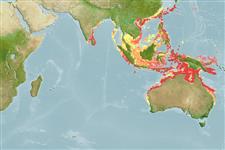Elasmobranchii (hajar och rockor) (sharks and rays) >
Rhinopristiformes (Shovelnose rays) >
Rhinidae (Wedgefishes)
Etymology: Rhynchobatus: Greek, rhingchos = snout + Greek, batis, -idos = a sting ray (Raja sp.) (Ref. 45335).
More on author: Whitley.
Environment: milieu / climate zone / djupintervall / distribution range
Ekologi
marina bottenlevande; djupintervall 0 - 60 m (Ref. 106604). Subtropical; 30°N - 30°S, 30°E - 155°E (Ref. 114953)
Indo-West Pacific: Red Sea, Persian Gulf (Ref. 114953). Gulf of Thailand and the Philippines to Queensland, Australia. A similar and perhaps identical species occurs in the western Indian Ocean off Mozambique and in the Gulf of Aden and is probably sympatric with the true 'Rhynchobatus djiddensis' of the western Indian Ocean and the Red Sea. Distributional range probably wider than reported, but many nominal records of Rhynchobatus djiddensis from the western Pacific and southeastern Indian Ocean cannot be identified to species.
Length at first maturity / Size / Vikt / Age
Könsmognad: Lm ?, range 155 - ? cm
Max length : 124 cm TL hane/ej könsbestämd; (Ref. 114953); 300.0 cm TL (female)
Inhabits inshore waters on the continental shelves (Ref. 9915). Demersal on soft bottoms and near coral reefs (Ref.58048). Female specimens may reach 300 cm in length in Thailand (Ref. 9915). Feeds on bottom crustaceans, mollusks (Ref. 9915) and bottom-dwelling fishes (Ref. 114953). Ovoviviparous (Ref. 50449). Caught commonly by demersal tangle net, and to a lesser extent by trawl and longline fisheries (Ref.58048). Marketed fresh; fins prized for the sharkfin trade (Ref. 9915).
Life cycle and mating behavior
Könsmognad | Reproduktion | Lek | Ägg | Fecundity | Larver
Exhibit ovoviparity (aplacental viviparity), with embryos feeding initially on yolk, then receiving additional nourishment from the mother by indirect absorption of uterine fluid enriched with mucus, fat or protein through specialised structures (Ref. 50449).
Compagno, L.J.V. and P.R. Last, 1999. Rhinidae (=Rhynchobatidae). Wedgefishes. p. 1418-1422. In K.E. Carpenter and V. Niem (eds.) FAO identification guide for fishery purposes. The Living Marine Resources of the Western Central Pacific. FAO, Rome. (Ref. 9915)
IUCN Red List Status (Ref. 130435: Version 2025-1)
Threat to humans
Harmless
Human uses
Fiskeri: kommersiell
Verktyg
Special reports
Download XML
Internet-källor
Estimates based on models
Preferred temperature (Ref.
123201): 23 - 28.4, mean 27.3 °C (based on 802 cells).
Phylogenetic diversity index (Ref.
82804): PD
50 = 0.5024 [Uniqueness, from 0.5 = low to 2.0 = high].
Bayesian length-weight: a=0.00372 (0.00163 - 0.00845), b=3.11 (2.91 - 3.31), in cm total length, based on LWR estimates for this (Sub)family-body shape (Ref.
93245).
Trofisk nivå (Ref.
69278): 3.5 ±0.50 se; based on food items.
Resiliens (Ref.
120179): Låg, lägsta populationsfördubblingstid 4,5-14 år (Fec assumed to be <100).
Fishing Vulnerability (Ref.
59153): Very high vulnerability (90 of 100).
🛈
Nutrients (Ref.
124155): Calcium = 24 [4, 109] mg/100g; Iron = 0.722 [0.186, 2.061] mg/100g; Protein = 19.3 [17.2, 21.3] %; Omega3 = 0.199 [0.088, 0.435] g/100g; Selenium = 23.8 [6.9, 67.8] μg/100g; VitaminA = 6.67 [2.30, 18.89] μg/100g; Zinc = 0.577 [0.286, 1.044] mg/100g (wet weight);
